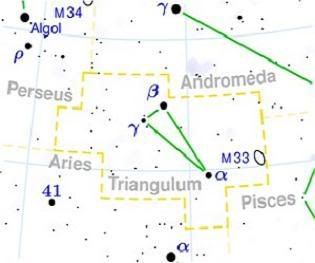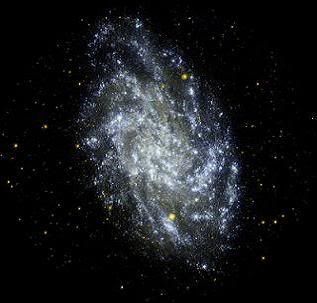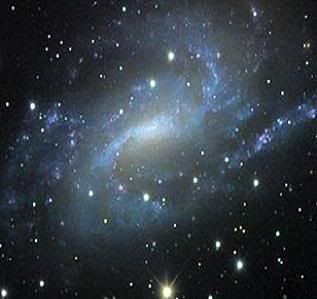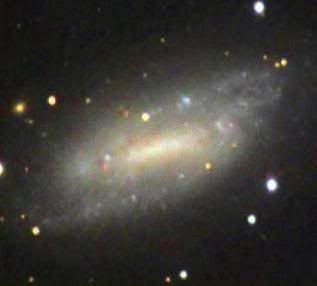Post by glactus on Feb 17, 2008 5:16:11 GMT

Triangulum is a small northern constellation whose three brightest stars, of third and fourth magnitude, form an elongated triangle. An early name of the constellation was Sicili, because Ceres, patron goddess of Sicily, was claimed to have begged Jupiter that the island be placed in the heavens.This Constellation boasts several deep sky objects for the amateur astonomer, and most interesting star fields.
Notable stars:
Alpha Trianguli
Alpha Trianguli is a yellow-white F-type subgiant with an apparent magnitude of 3.42. Its mass is about 1.5 times that of the Sun. This star is a spectroscopic binary whose component has an orbital period of only 1.74 days. The companion star is a mere 6 million km (3.7 million miles) from the main star. The whole system is approximately 64.1 light years from Earth.
6 Trianguli
One star of interest is 6 Trianguli. This is a pleasant binary - a bright yellow primary with a blue companion, clearly visible in small telescopes; At a distance of 305 light years, it is classed as a combination fifth magnitude G5 giant, plus a fainter magnitude 6.44 F5 dwarf, the two stars separate by 3.8 seconds of arc.
Gamma Trianguli
Gamma Trianguli (y Trianguli) is a white A-type main sequence dwarf with an apparent magnitude of 4.03, and approximately 118 light years from Earth. It shines with the luminosity of 28 Suns and is a champion spinner, rotating with a speed of at least 208 kilometers per second, 104 times that of the Sun.
Delta Trianguli
DeltaTrianguli (q Trianguli) is a spectroscopic binary star system at approximately 35 light-years distant. The A star is a yellow dwarf and with a mass higher than the Sun. Its companion, Delta Trianguli B, is an orange dwarf of spectral type K4V. They orbit each other every 10.02 days in a circular orbit with a low eccentricity. Magnitude is 4.68
Notable objects:

Messier M 33
The Triangulum Galaxy, M33, (NGC 598) is one of the members of the Local Group, and about 2.9 million light years from Earth. Being at magnitude 5.8, the galaxy is sufficiently bright enough to be glimpsed with the naked eye under dark skies. According to recent work of the early 1990s, M33 is a bit farther away from us than the Andromeda Galaxy M31, and perceived to be a starburst galaxy.

NGC 604
NGC 604 is an H II region inside the Triangulum Galaxy and is one of the largest of its kind in the Local Group. At the heart of NGC 604 are over 200 hot stars, much more massive than our Sun (15 to 60 solar masses). They heat the gaseous walls of the nebula making the gas flouresce. Their light also highlights the nebula's three-dimensional shape, like a lantern in a cave. Apparent magnitude is 14.0, and distance from Earth is of 2.7 million light-years.

NGC 925
NGC 925 is a nearly face-on spiral galaxy and part of the Hubble Space Telescope Key Project on the Extragalactic Distance Scale, a long-term project dedicated to determining the Hubble constant which defines the relationship between the distance of a galaxy and its recession velocity due to the expansion of the Universe. Knowing this relationship more precisely will give us a more accurate measure of the age of the Universe. NGC 925 lies approximately 30 million light years away from Earth, and has a magnitude of 10.4.

NGC 672
NGC 672 in one of two interacting galaxies, (the other being IC 1727) some 18 million light years distant. From each other they are separated by only 88,000 light years- little more than their own diameters. While outside of the "Local Group" of galaxies, NGC 672 is close enough to begin to resolve some of the brighter stellar associations and dust lanes. This gives the galaxy its granulated and bumpy appearence. By examining both galaxies in the radio wavelengths of light, astronomers have detected a large envelope of gas that surround these galactic friends. Magnitude is 10.9

credits:
Triangulum map: Wikipedia
en.wikipedia.org/wiki/Triangulum
image: M 33
en.wikipedia.org/wiki/Triangulum_Galaxy
image: NGC 604 ; Wikipedia
en.wikipedia.org/wiki/Image:Triangulum.nebula.full.jpg
image: NGC 672: astrosurf.com
www.astrosurf.com/skylink/deepsky/ngc0000/NGC0672.jpg
image: NGC 925: mistisoftware.com
www.mistisoftware.com/astronomy/Galaxies_ngc925.htm


